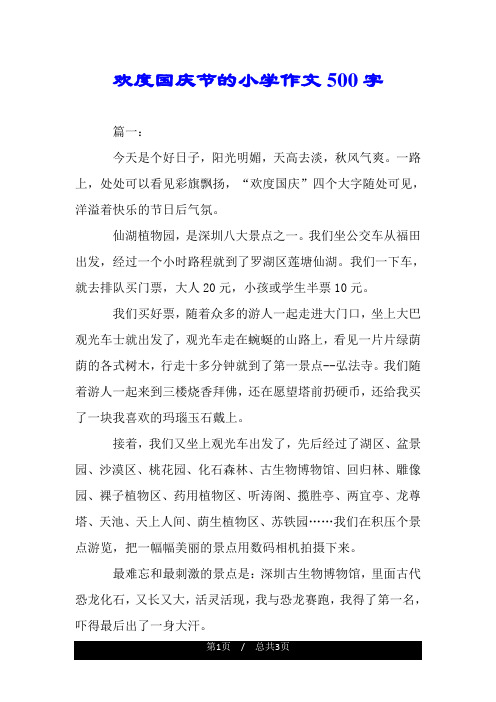英语作文常用句型(英语句型)
英语作文常用句型
1.简单句型(Simple Sentences) - 陈述句:这是最常见的句子结构,用来说明事实或提供信息。例如,“I go to school by bus every day.” - 疑问句:用于提出问题或寻求答案。如“Does he like reading?” - 否定句:用来表示不同意或拒绝某事。如 “I do not like this movie” - 命令句:用来发出指令或请求。例如, "Please clean the room." - 感叹句:用来表达强烈的情感或惊讶。比如,"How wonderful it is to have a friend like you!"
2.并列句型(Compound Sentences) - 并列句是由两个或多个相同成分的句子组成,这些成分通常是并列连词,如 and, but, or。例如,“He is good at playing basketball, but he is not good at math.” - 选择句型:由一个主句和一个从句组成,从句通常用连词连接,如 if, whether, when, where, why等。例如,“Whether I should go there tomorrow morning or not, I am still unsure.” - 因果句型:由一个主句和一个从句组成,从句解释为什么主句发生。例如,“The reason why she failed was her lack of preparation.”
3.复合句型(Complex Sentences) - 复杂句型是由两个或多个独立的句子组成的,它们之间通过逗号或其他标点符号隔开。例如,“She has a great job, enjoys it, and loves her life.” - 条件句型:由一个主句和一个条件状语从句构成,条件状语从句通常用if引导。例如,“If he finishes his homework on time, we will reward him.” - 时间状语从句:用来描述动作发生的时间或条件。例如,“When the sun rises, it brings us hope.” - 目的状语从句:用来说明动作的目的。例如,“We went to the park to have fun with our friends.”
4.强调句型(Emphatic Sentences) - 强调句型是一种特殊形式的被动语态,它强调的是主语而不是谓语动词。例如,“It was said that she would come to our house tonight.” - 宾语从句:用来回答前面提出的问题。如 “What does your mother do for a living?” - 表语从句:用来补充说明主语的性质、特征或状态。例如,“He is a teacher; he teaches English.”
5.让步句型(Conditional Sentences) - 让步句型是用来表达一种让步关系的句子,即在某些情况下,虽然有某种情况存在,但结果并不重要。例如:“Though he did not pass the exam, he did not give up.” - 虚拟语气:用来描述一种假设的情景。例如,“If it rained tomorrow, we would stay indoors.” - 让步状语从句:用来表示让步关系,常与but, however等连词一起使用。例如,“Although she had a difficult time learning a new skill, she never gave up.”
6.倒装句型(Inversion Sentences) - 倒装句型是指将正常顺序的单词或短语颠倒位置。这种句型可以使句子更加紧凑和有力。例如,“To be honest, I don't think it is a good idea。” - AUXILIARY VERB: 倒装部分是助动词do/does/did/didn't等,通常位于主动部分之前。例如,“Do as I say.” - SUBJECT VERB INVERTED: 主动部分是句子的主语和动词,通常位于副词之前。例如,“The book was read by the teacher.” - AUXILIARY VERB + SUBJECT VERB INVERTED: 主动部分和倒装部分同时出现,通常位于主语之后和谓语之前。例如,“I saw him enter the classroom.”
7.比较级+名词/形容词+副词/动词 - 比较级+名词:表示两者之间的比较。例如,“This is bigger than that one.” - 比较级+形容词:表示两者之间的质量差异。如“These shoes are more comfortable than the others.” - 比较级+副词:表示速度或程度的差异。例如,“She runs faster than he does.” - 比较级+动词:表示能力或成就的差异。比如,“He is smarter than I am.”
8.分词结构(Phrase Composition) - 不定式结构:表示目的、原因、结果等。例如,“To study harder, he decided to take a rest.” - 动名词结构:表示行为或状态。例如,“Swimming is my favorite sport.” - 过去分词结构:表示完成的动作。例如,“Having finished the work, they sat down to relax.” - 现在分词结构:表示进行时的动作。例如,“Looking forward to seeing her again, I am excited.”
9.介词短语 - 介词短语用来修饰名词、代词、动词或形容词。例如,“By car, we arrived at the destination early.” - 介词短语还可以表示时间和地点。比如,“At seven o'clock in the morning, she usually goes to the library.” 总结:英语写作中,掌握并正确使用上述各种句型对于清晰、准确地传达思想至关重要。无论是简单句还是复合句,都需要根据上下文和语境选择合适的句型来表达自己的观点和想法。通过不断练习和积累,我们能够写出更具说服力和感染力的文章。
在英语写作中,掌握和使用正确的句型对于表达清晰、准确的思想至关重要。一个好的句型不仅能让读者快速理解作者的意图,还能增强文章的可读性和逻辑性。本文将介绍一些常见的英语写作句型,帮助提高您的写作技巧。
1.简单句型(Simple Sentences) - 陈述句:这是最常见的句子结构,用来说明事实或提供信息。例如,“I go to school by bus every day.” - 疑问句:用于提出问题或寻求答案。如“Does he like reading?” - 否定句:用来表示不同意或拒绝某事。如 “I do not like this movie” - 命令句:用来发出指令或请求。例如, "Please clean the room." - 感叹句:用来表达强烈的情感或惊讶。比如,"How wonderful it is to have a friend like you!"
2.并列句型(Compound Sentences) - 并列句是由两个或多个相同成分的句子组成,这些成分通常是并列连词,如 and, but, or。例如,“He is good at playing basketball, but he is not good at math.” - 选择句型:由一个主句和一个从句组成,从句通常用连词连接,如 if, whether, when, where, why等。例如,“Whether I should go there tomorrow morning or not, I am still unsure.” - 因果句型:由一个主句和一个从句组成,从句解释为什么主句发生。例如,“The reason why she failed was her lack of preparation.”
3.复合句型(Complex Sentences) - 复杂句型是由两个或多个独立的句子组成的,它们之间通过逗号或其他标点符号隔开。例如,“She has a great job, enjoys it, and loves her life.” - 条件句型:由一个主句和一个条件状语从句构成,条件状语从句通常用if引导。例如,“If he finishes his homework on time, we will reward him.” - 时间状语从句:用来描述动作发生的时间或条件。例如,“When the sun rises, it brings us hope.” - 目的状语从句:用来说明动作的目的。例如,“We went to the park to have fun with our friends.”
4.强调句型(Emphatic Sentences) - 强调句型是一种特殊形式的被动语态,它强调的是主语而不是谓语动词。例如,“It was said that she would come to our house tonight.” - 宾语从句:用来回答前面提出的问题。如 “What does your mother do for a living?” - 表语从句:用来补充说明主语的性质、特征或状态。例如,“He is a teacher; he teaches English.”
5.让步句型(Conditional Sentences) - 让步句型是用来表达一种让步关系的句子,即在某些情况下,虽然有某种情况存在,但结果并不重要。例如:“Though he did not pass the exam, he did not give up.” - 虚拟语气:用来描述一种假设的情景。例如,“If it rained tomorrow, we would stay indoors.” - 让步状语从句:用来表示让步关系,常与but, however等连词一起使用。例如,“Although she had a difficult time learning a new skill, she never gave up.”
6.倒装句型(Inversion Sentences) - 倒装句型是指将正常顺序的单词或短语颠倒位置。这种句型可以使句子更加紧凑和有力。例如,“To be honest, I don't think it is a good idea。” - AUXILIARY VERB: 倒装部分是助动词do/does/did/didn't等,通常位于主动部分之前。例如,“Do as I say.” - SUBJECT VERB INVERTED: 主动部分是句子的主语和动词,通常位于副词之前。例如,“The book was read by the teacher.” - AUXILIARY VERB + SUBJECT VERB INVERTED: 主动部分和倒装部分同时出现,通常位于主语之后和谓语之前。例如,“I saw him enter the classroom.”
7.比较级+名词/形容词+副词/动词 - 比较级+名词:表示两者之间的比较。例如,“This is bigger than that one.” - 比较级+形容词:表示两者之间的质量差异。如“These shoes are more comfortable than the others.” - 比较级+副词:表示速度或程度的差异。例如,“She runs faster than he does.” - 比较级+动词:表示能力或成就的差异。比如,“He is smarter than I am.”
8.分词结构(Phrase Composition) - 不定式结构:表示目的、原因、结果等。例如,“To study harder, he decided to take a rest.” - 动名词结构:表示行为或状态。例如,“Swimming is my favorite sport.” - 过去分词结构:表示完成的动作。例如,“Having finished the work, they sat down to relax.” - 现在分词结构:表示进行时的动作。例如,“Looking forward to seeing her again, I am excited.”
9.介词短语 - 介词短语用来修饰名词、代词、动词或形容词。例如,“By car, we arrived at the destination early.” - 介词短语还可以表示时间和地点。比如,“At seven o'clock in the morning, she usually goes to the library.” 总结:英语写作中,掌握并正确使用上述各种句型对于清晰、准确地传达思想至关重要。无论是简单句还是复合句,都需要根据上下文和语境选择合适的句型来表达自己的观点和想法。通过不断练习和积累,我们能够写出更具说服力和感染力的文章。




